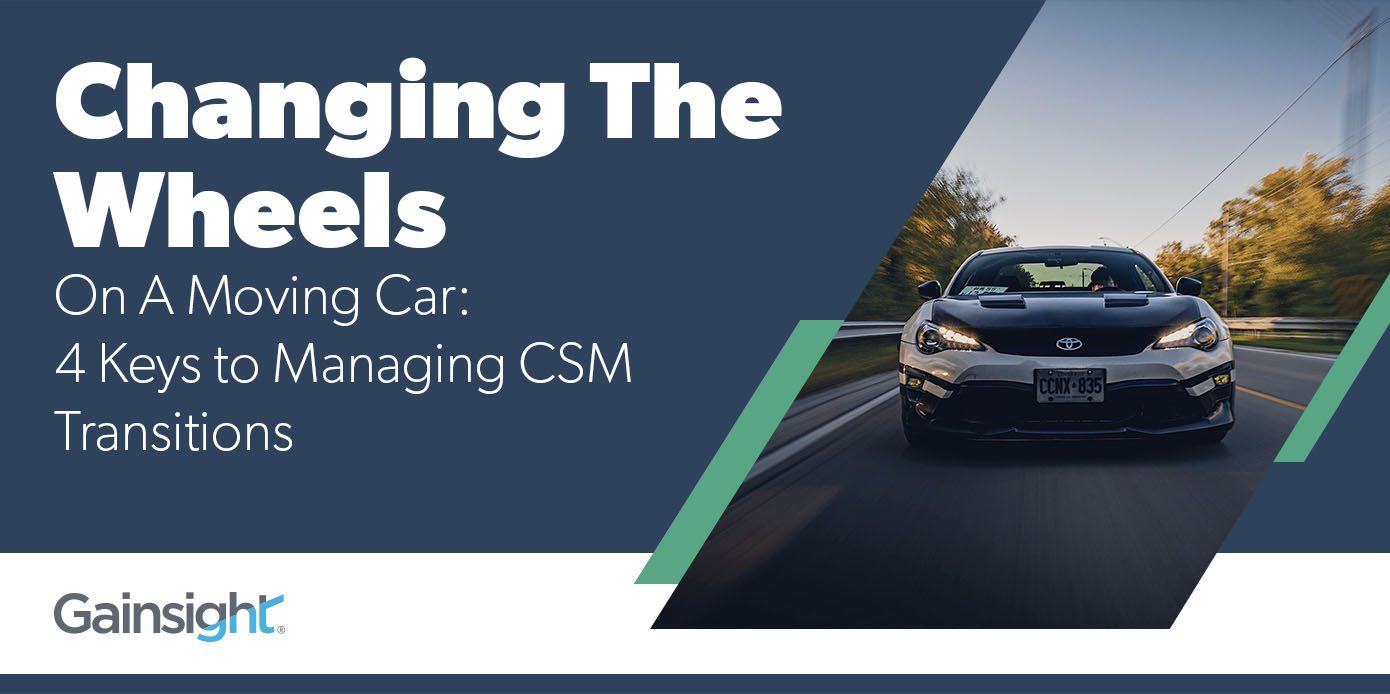There is an old joke: A car mechanic was performing routine service for his trusted client, a cardiac surgeon, while the surgeon waited in the lounge. At the end of it, while settling the bill, the mechanic turned to the cardiac surgeon and said “I don’t know why you are paid so much more than me, doc. Both of us change valves on an engine”. The surgeon smiled and replied “True. But have you ever tried changing the valves on a running engine”. That is exactly the complexity that comes with changing a CSM on a running book of business (BoB).
To apply Maxwell’s maxim ‘Change is inevitable, growth is optional’ to the Customer Success world, there is no reason why an account should suffer from lack of attention or a growth crisis even as the CSMs transition in and out, which they inevitably will. In fact, a true CSM solution makes this change as seamless as possible.
Transitions will happen due to a multitude of reasons. Employee attrition. Employee growth. Internal reorganizations. As we think about the new world we are in, some of these are inevitable. Sometimes, the timing can be partially controlled, but for many reasons it can be an unplanned events to which we need to respond (hiring freeze, family care, maternity and paternity leaves, team changes due to an economic downturn, and other emergencies).
So what makes a transition ideal? To answer this question, we need to take a look at it from the lens of both the customer as well as internal stakeholders.
From the customer’s perspective, the transition should involve as little disruption as possible. Usually they are not the ones who initiate the transitions, so they don’t like bearing the brunt of it, in having to reinvent the wheel and teach the new CSM everything. They want the new CSM to hit the ground running from the get go and have complete context of:
- The customer’s goals, use cases, priorities, metrics, organizational specific information down to the level of when does their fiscal year start.
- How the product is being used in customer’s organization, which teams are using your solution and how, and how does the customer want to use your product in the future to accomplish their goals?
- What does the customer contract look like, what are they entitled to and where are they looking to expand?
- Challenges and areas of improvement in your solution that the customer cares about and have brought up during the course of relationship.
- Context of any ongoing project, services engagement or a roll-out of a new product at the customer, as it relates to your solution.
From a CS organization perspective, during an ideal transition, the incoming CSM should acquire as much of tribal knowledge as possible. They have an understanding of:
- The roles of the various stakeholders in the customer’s organization, their responsibilities, and their decision making powers.The CSM should know the de jure power centers from de facto ones, who the influencers are what does their organizational chart look like?
- The natural pace of decision making at the customer’s organization: Do they move fast or are they generally cautious or require a lot of convincing when we propose a change, new service, new process or new product that we think can help them?
- What’s the customer’s tech stack look like? Which other solutions do customers use that work adjacent to our solution?
- What is implemented and what is planned in the foreseeable future? Are there any deadlines that we need to be aware of?
- The history of the relationship with the customer. Was this an M&A customer, were there any struggles during implementation, do we have common VCs, have we partnered with this customer and in what capacity etc.
I recently moved from managing the SMB customer segment into a similar role in the enterprise segment. As I transitioned 40+ customers from my BoB in 2 weeks, I was well aware of the challenges it would pose both to the incoming CSMs (there were multiple CSMs across which my existing BoB will be distributed) and to the customers.
My goal was to make this experience as seamless as possible, to not lose any context of the relationship in the transition and to ensure that all of this information is in a place that is easily referenceable. Additionally, I wanted my managers to have a complete line of sight on where I was with these customer transitions.
Using decks and spreadsheets or an equivalent external tool was out of the question because:
- It would be tedious to create 40+ presentations, one per customer, which is not ideal for the outgoing CSM.
- It would distribute data out of Gainsight, which is the primary tool that our team uses to manage our BoB.
- It would be hard to maintain. Whenever you use one more tool to store your customer information, you add that many steps into your workflow. Not to mention it disperses your information into multiple areas. And what happens when you have to transition that customer?! That’s right, you have to find a way to consolidate all the sources where this information is scattered (or leave the burden to consolidate info to the incoming CSM – I will only do that if I particularly hate the person taking over from me but that was not the case).
This is how I accomplished these transitions in Gainsight. Four simple tools but very effective! I did not have to leave the Customer 360 page even once, from the time I started the transition to the time I had the final transition call with the customer.
1. Transition Playbook:
As soon as I was ready to transition, I used our transition playbook that highlights the step by step actions to make sure that I am:
- Reaching out to the right stakeholders on time
- Checking contact information to make sure that it is current
- Making the org chart current, if not already
- Updating customer goals and any contextual information of the customer
- Updating the internal context of the customer
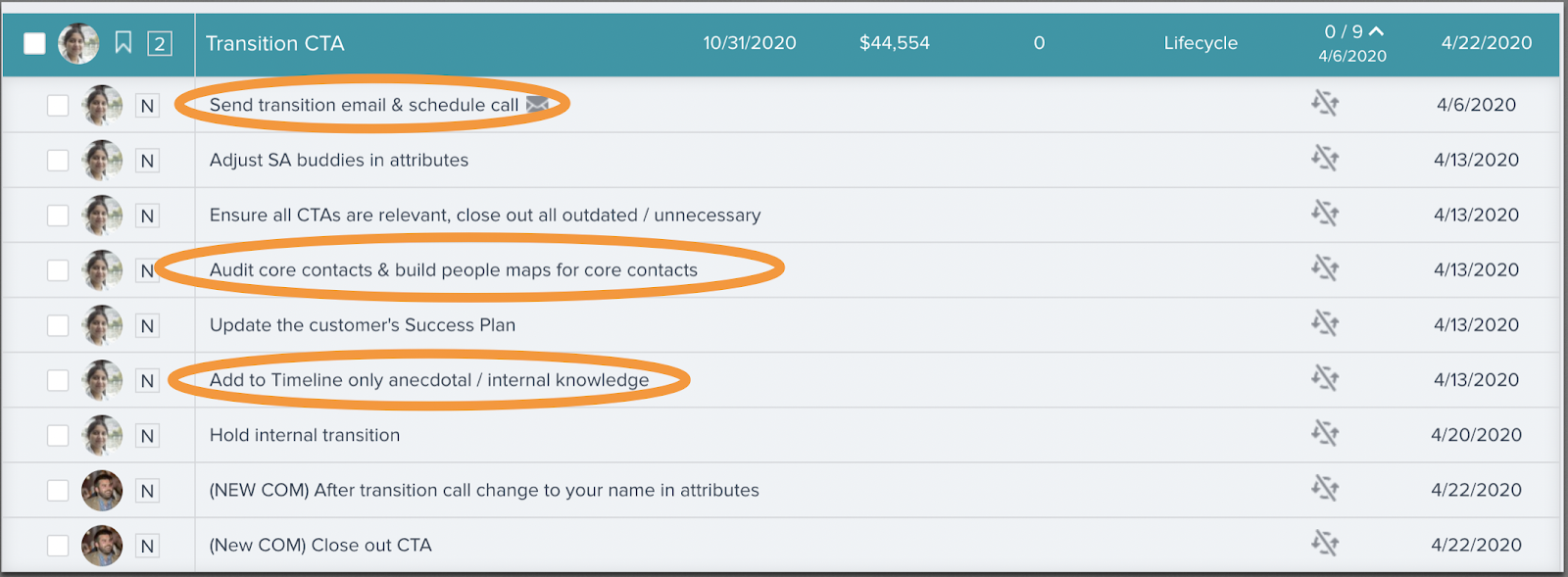
You will notice that there is an email icon next to the first task which allows me to send a message informing the customer about the upcoming CSM transition without leaving this screen. I can also personalize this before hitting send. This is an example of how this email task looks from the CSM perspective:
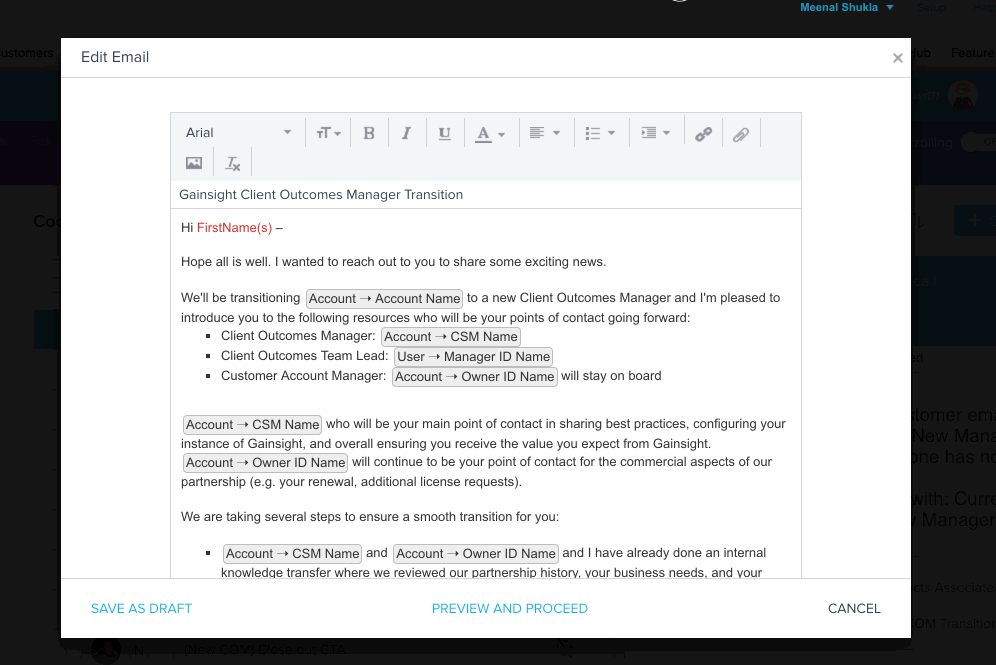
As I went through these tasks, I marked them as complete. My managers could easily see where I am with each of my transitions and how they are progressing.
2. Timeline to add internal context:
This is where I add all the internal customer context along with commentary on relationships with the different stakeholders in the customer’s organization. In this example, I have also added COVID-19 impact and have categorized high risk customers (Nick Mehta and Bessemer conducted a widely appreciated webinar on how to manage churn and categorize customers to estimate the impact of COVID-19 in case you want to learn more). As this is internal, I could add information around any blockers, challenges with the customer and past issues.
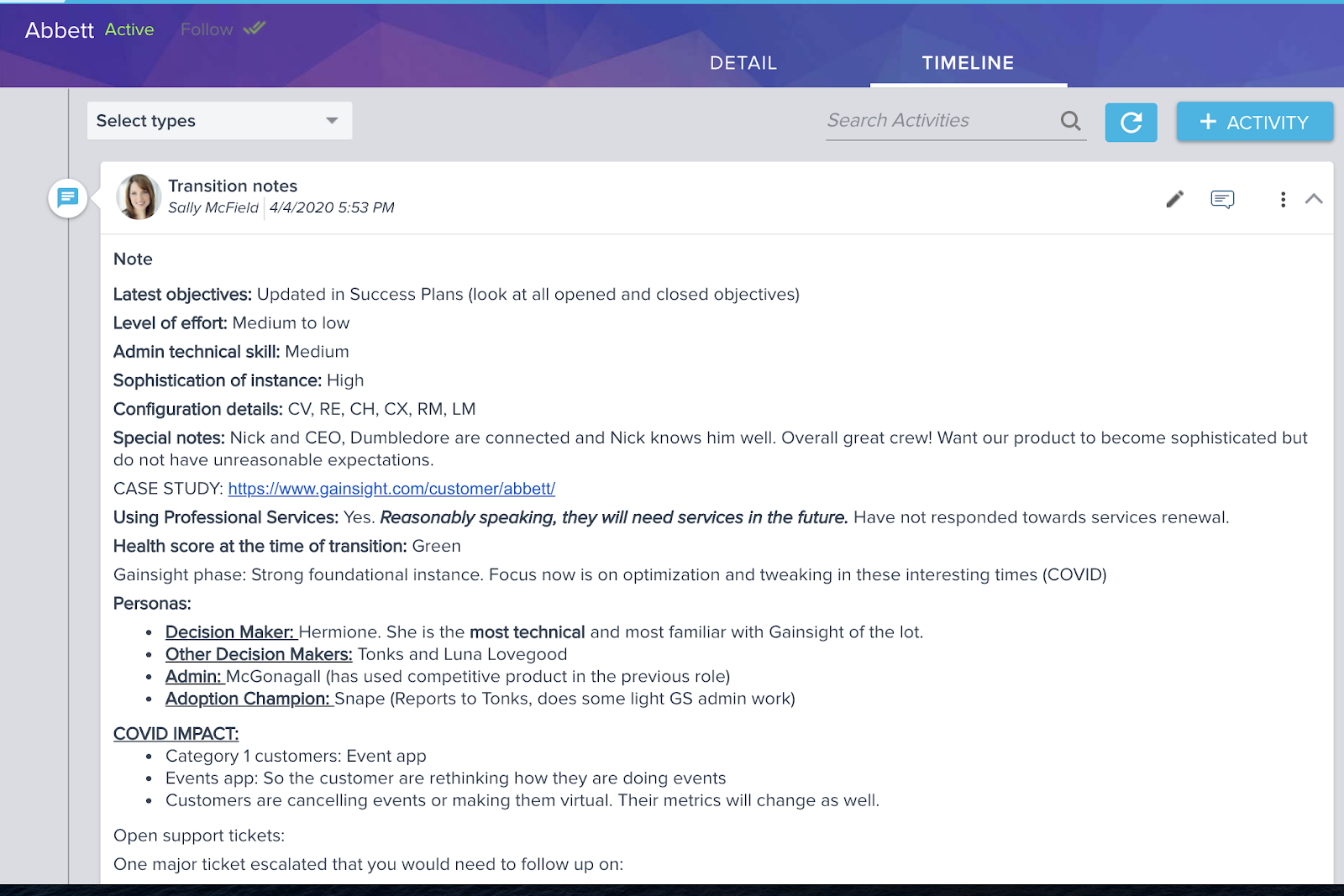
3. People Maps to visually understand customer’s team hierarchies:
I also make sure that I am updating any contact data as a part of this transition. We use People Maps to keep track of organizational charts and visualize how strongly contacts influence one another in the organization in order to understand who can champion or derail a deal.:
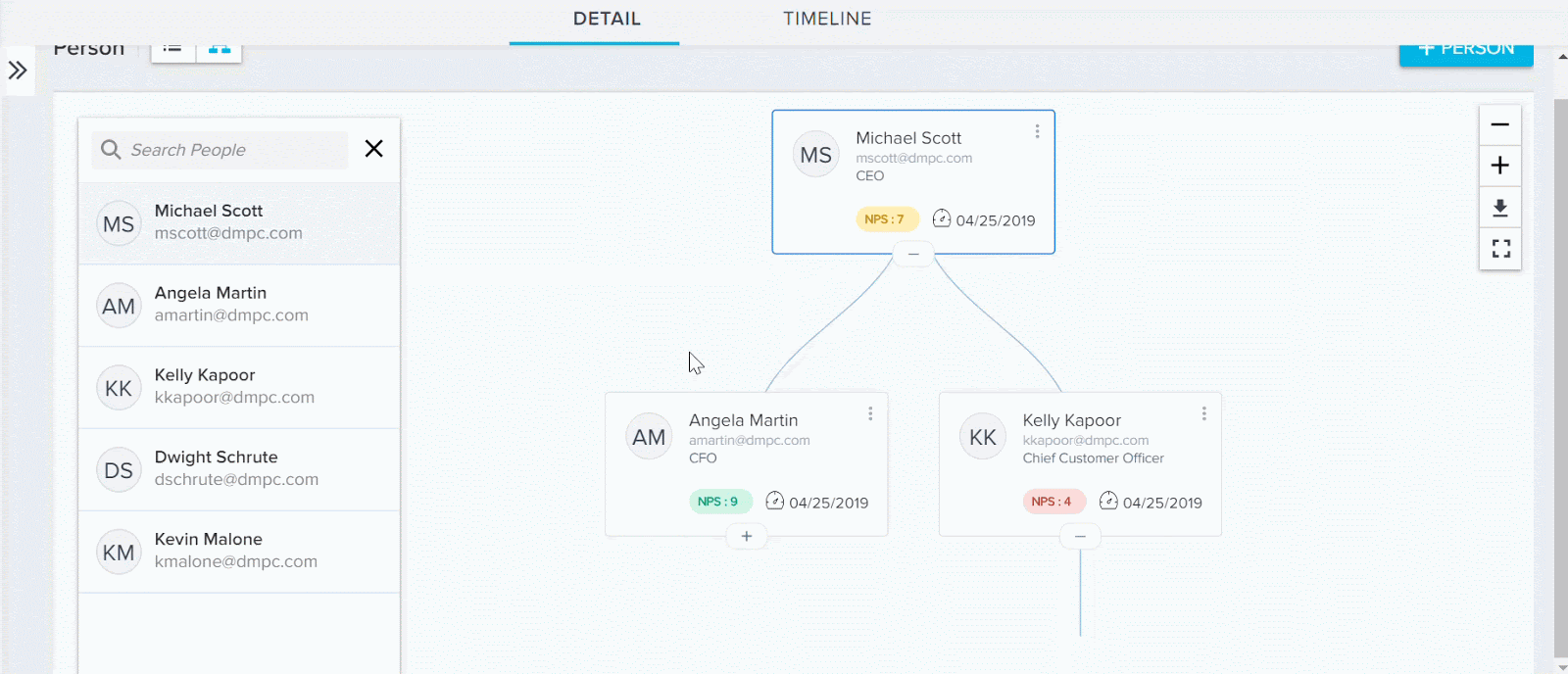
4. Success Plans to add customer goals, metrics, initiatives and progress towards the goals:
Success Plans is where I can systematically capture customer objectives and update customer goals, metrics and business priorities. We also bring information from the original sale here to understand the buying psychology from the original deal. We create individualized Success Plans to track progress of granular customer relationships for various products, departments, or locations.
Bonus: This is also the place where we record our accomplishments for the customer throughout the course of our relationship with them.
I run my transition calls with my customer leveraging Success Plans to 1) Give them confidence in adequately capturing the history, stakeholder inputs and background of the relationship 2) Provide the incoming CSM a centralized location on all things related to the customer (without looking at spreadsheets, powerpoints, google docs, Evernote, etc. to determine the validity and timeliness of the data they are reviewing).
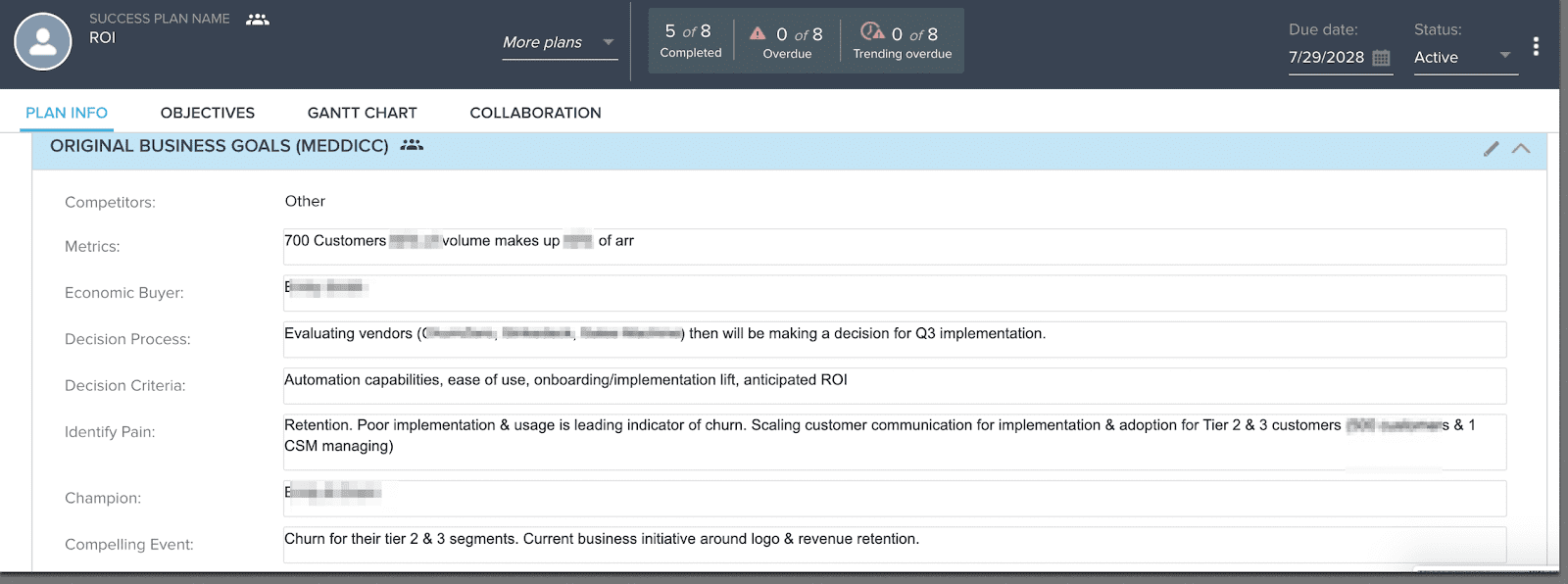




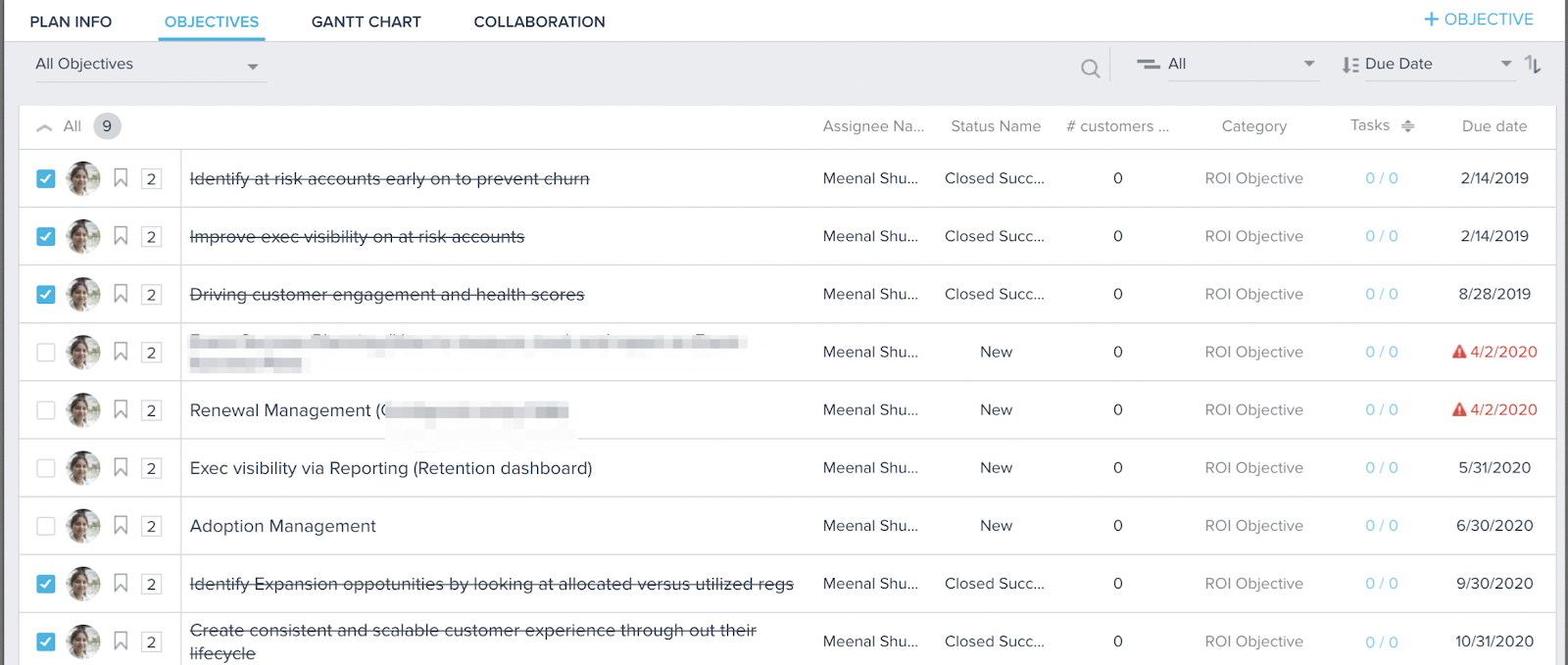
So there you have it! Since then I have done 25 more transitions. I can tell you from one CS professional to another that using these four tools have helped me sort out my day and priorities much better than I could have hoped for by solely relying on PPT and Excel.
Leveraging the process described above has helped me arm the incoming CSM with deep customer context, provide visibility to my managers on the progress of transitions and have helped ensure that our customer does not have to reinvent the wheel with my successor.
During this difficult time of likely transition, I hope this helps you as much it has helped me. I would love to know what else you have found useful as you or your teams move their BoB around.
